When choosing between vinyl and laminate flooring, it’s important to consider factors like water resistance, durability, comfort, and cost. Both options offer DIY-friendly installation and a stylish wood-like appearance, but they have key differences that impact their performance in different environments. The table below provides a quick comparison to help you decide which flooring type best suits your needs.
Key Takeaways
Vinyl Flooring: Best for moisture-prone areas like bathrooms, kitchens, and basements. It’s waterproof, durable, and slightly more expensive than laminate.Laminate Flooring: Ideal for living rooms, bedrooms, and dry spaces, where a realistic wood look is preferred. It’s more affordable but less resistant to water.
Vinyl vs Laminate Comparison
| Flooring Type | Water Resistance | Appearance | Durability | Installation | Comfort | Cost |
| Vinyl Flooring | Waterproof | Realistic but less textured | Highly durable | DIY-friendly | Softer and warmer | Generally affordable |
| Laminate Flooring | Water-resistant but not waterproof | More realistic wood look | Scratch-resistant but vulnerable to moisture | DIY-friendly but requires underlayment | Firmer underfoot | Slightly cheaper than luxury vinyl |
What is Vinyl Flooring?
Vinyl flooring is a synthetic flooring material made primarily from polyvinyl chloride (PVC). It is available in various formats, including sheets, planks, and tiles. Known for its durability and water resistance, vinyl flooring is a popular choice for areas prone to moisture, such as kitchens and bathrooms.
Vinyl flooring has a smooth, slightly soft feel underfoot, especially if it has a cushioned backing. It tends to feel warmer than tile and provides a slight give when walked on, making it comfortable for extended standing periods.
Benefits of Vinyl Flooring:
- Water-resistant and ideal for humid environments
- Comfortable underfoot with a cushioned backing
- Available in a wide variety of styles and designs
- Low maintenance and easy to clean
- DIY-friendly installation with peel-and-stick or click-lock options

What is Laminate Flooring?
Laminate flooring consists of a fibreboard core topped with a photographic layer that mimics natural materials such as wood or stone. It is designed to provide the look of hardwood at a more affordable price point.
Laminate flooring feels firmer underfoot compared to vinyl due to its dense fiberboard core. While it doesn’t have the same level of softness as vinyl, it offers a realistic texture that can closely resemble natural wood or stone.
Benefits of Laminate Flooring:
- Affordable and budget-friendly
- Realistic wood and stone appearances
- Easy to install with a floating floor system
- More scratch-resistant than vinyl
- Comfortable underfoot with an attached underlayment

Key Differences Between Vinyl and Laminate Flooring
Appearance & Feel
Both vinyl and laminate flooring can mimic hardwood, stone, or tile, but laminate flooring often has a more realistic texture and depth due to its photographic layer. Vinyl flooring, particularly luxury vinyl plank (LVP) and luxury vinyl tile (LVT), has improved significantly in realism over the years.
Vinyl Flooring Texture: Typically smooth with a slight give, though textured options are available to mimic wood grain or stone surfaces. It has a slightly cushioned feel, especially with underlayment, making it softer underfoot.
Laminate Flooring Texture: More rigid and firm underfoot, often featuring embossed or hand-scraped textures that closely resemble real hardwood. Some laminate floors have a slight grainy texture to mimic the feel of natural wood, enhancing realism.
Both vinyl and laminate flooring can mimic hardwood, stone, or tile, but laminate flooring often has a more realistic texture and depth due to its photographic layer. Vinyl flooring, particularly luxury vinyl plank (LVP) and luxury vinyl tile (LVT), has improved significantly in realism over the years.
Cost
Vinyl Flooring: Typically ranges from $1 to $7 per square foot. Standard vinyl options like sheet vinyl and basic luxury vinyl tiles (LVT) are on the lower end of the price range, while high-end luxury vinyl planks (LVP) with enhanced durability and realism can cost more. Installation costs can also vary depending on whether you choose peel-and-stick, glue-down, or floating click-lock vinyl.
Laminate Flooring: Generally costs between $1 to $5 per square foot, making it a slightly more affordable option than luxury vinyl. The cost can increase with higher-end options that feature thicker boards, enhanced water resistance, or textured surfaces that mimic real wood more closely. Installation is usually more straightforward but may require an underlayment, which can add to the overall cost.
Water Resistance
Vinyl Flooring: 100% waterproof, making it ideal for bathrooms, kitchens, and basements. It can handle everyday spills, wet boots, and even puddles without damage.
Laminate Flooring: Water-resistant but not entirely waterproof. It can handle minor spills if wiped up quickly, but standing water left for too long may lead to swelling and warping.
Heat Resistance
Vinyl Flooring: Can tolerate moderate heat but may expand or warp with sudden or prolonged exposure to extreme temperatures, such as direct sunlight or intense heat sources.
Laminate Flooring: More resistant to heat but can still be affected by extreme conditions, such as prolonged exposure to direct sunlight, which may cause fading or warping over time.
Installation
Both vinyl and laminate flooring are DIY-friendly, but they have different installation methods:
Vinyl Flooring: Available in peel-and-stick, glue-down, and click-lock options. Peel-and-stick vinyl is the easiest to install, requiring only a clean, smooth surface for adhesion. Glue-down vinyl provides a more permanent solution and is ideal for high-traffic areas, while click-lock vinyl is designed for floating installations and can be installed over existing floors without adhesives.
Laminate Flooring: Installed as a floating floor using a tongue-and-groove locking system. This means the planks snap together without nails or glue, making installation straightforward. However, a proper underlayment is recommended to improve stability, sound absorption, and moisture resistance. While DIY-friendly, cutting laminate to fit around obstacles may require additional tools like a jigsaw or table saw.

Lifespan & Durability
Vinyl Flooring: Can last 10-20 years with proper care. Regular maintenance includes sweeping or vacuuming to remove debris, occasional mopping with a vinyl-safe cleaner, and avoiding harsh chemicals or abrasive scrubbers. Without proper care, dirt buildup can dull the finish, and heavy furniture or sharp objects may cause dents or tears.
Laminate Flooring: Typically lasts 10-30 years, depending on quality and maintenance. Proper care includes sweeping or dry mopping to prevent dirt accumulation, using a damp (not wet) mop for deeper cleaning, and avoiding excessive moisture. Without regular upkeep, dirt and grit can scratch the surface, and prolonged water exposure may lead to warping or swelling.
Radiant Heating Compatibility
Both vinyl and laminate flooring can work with radiant heating systems, but it is essential to check the manufacturer's recommendations. Some vinyl flooring options may not be suitable for high-heat exposure, while laminate flooring should have a proper underlayment to prevent heat damage.

Final Thoughts on Vinyl Versus Laminate Flooring
When choosing between vinyl and laminate flooring, consider your space's moisture levels, desired appearance, and budget. If you need a waterproof solution, vinyl is the better choice. If you want a more natural-looking wood appearance and don’t have to worry about water exposure, laminate could be the right fit for you.By considering these factors, you can make an informed decision about which flooring type best suits your home. Whether you choose vinyl or laminate, both options offer stylish, budget-friendly, and durable flooring solutions.
What are floating floorboards?
Floating floorboards refer to flooring that is not directly glued or nailed to the subfloor. Instead, they use a click-lock mechanism that allows them to "float" over an underlayment. Both laminate and some types of vinyl flooring use this method.
Is vinyl flooring better than laminate flooring?
The best choice depends on your needs. Vinyl is better for moisture-prone areas due to its waterproof nature, while laminate offers a more realistic wood appearance and a warmer feel underfoot.
What do you put under laminate flooring?
An underlayment is typically placed under laminate flooring to provide cushioning, reduce noise, and create a moisture barrier. Common underlayment materials include foam, cork, and rubber.



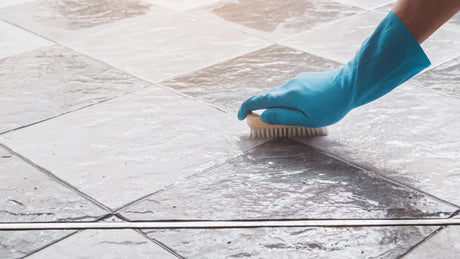
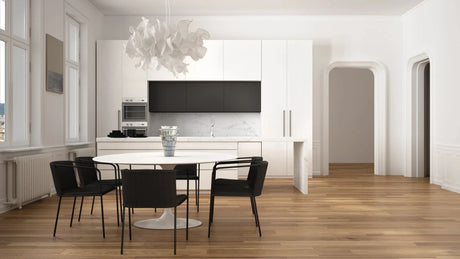
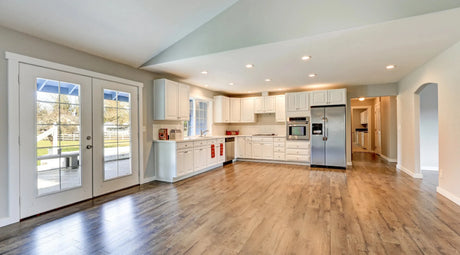
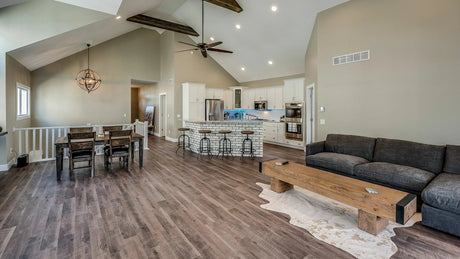
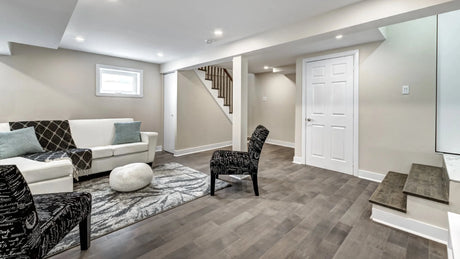
 https://bessofloor.com
https://bessofloor.com